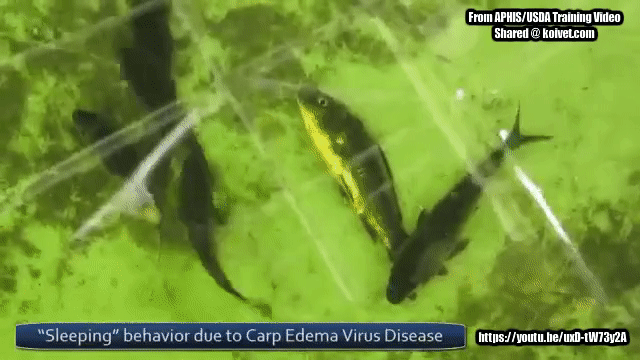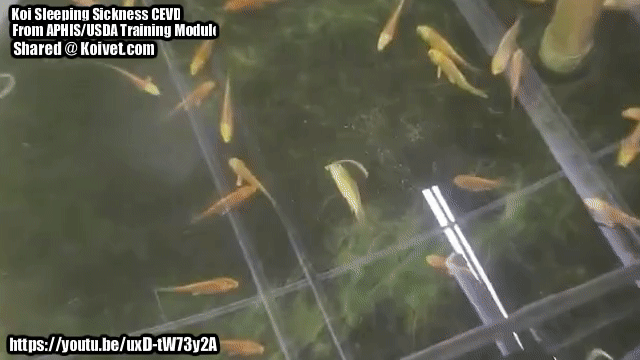
Carp Edema Virus Disease (CEVD) (Koi Sleeping Sickness)
Dr Johnson: “I am no genius. This information is directly from USDA/Accreditation information from APHIS/USDA. I’d seen “sleeping sickness” for decades and never knew there was a virus with it. Most of the time when you’d warm the fish up, salt them, kill off any parasites they might have had, they’d clear up. Never knew there was a virus and all we were doing is alleviating stress which allowed the fish to withstand it.”
Carp Edema Virus Disease (CEVD)
Causative Agent and Host Range
Carp edema virus disease, also called koi sleepy disease, is caused by the carp edema virus, a large DNA virus that is thought to belong to the family Poxviridae; it is an emerging cyprinid pathogen.
The virus can cause disease in wild and cultured common carp varieties, including koi. Disease caused by this virus was first seen in Japan in the mid-1970s. Since then, outbreaks have been documented in North America, Europe, and the United Kingdom.
Clinical Signs
Video: https://youtu.be/uxD-tW73y2A
Clinical signs and lesions of CEVD may include the following:
- Lethargy and unresponsiveness;
- Juveniles may hang just under the surface of the water; adult fish may lie motionless on the bottom of their pond or tank.
- Note: Individuals from both groups may respond to tapping on the tank or other stimulation by swimming momentarily and then returning to their previous position (see the video below). This clinical sign is not pathognomonic for CEVD.
- Anorexia;
- Erosive or hemorrhagic skin lesions with edematous swelling of the underlying tissues;
- Enophthalmos (sunken eyes);
- Pale, swollen gills; and
- Patchy areas of gill discolorations or necrosis.
Transmission and Disease Expression
Disease often occurs in juvenile koi when they have been stressed due to movement from earthen nursery ponds to concrete-lined ponds for grading. Outbreaks also occur after the addition of infected fish into a population that has not previously been exposed to the pathogen.
One study showed that mortality may begin in naïve koi or common carp at 6–16 days post exposure by immersion. This study also suggested that transmission occurred via contaminated water, so affected fish likely shed the virus from skin and gill lesions.
The length of time that the virus can survive in water and the possibility of vertical transmission are unknown.
Diagnosis

In addition to a case history and clinical signs consistent with the disease, examination of wet mounts of the gills is helpful. Affected fish show a proliferation of gill epithelial cells and thickening of the gill filament. In early stages of the disease, this thickening occurs at the tips of the gill filaments, creating a “club-like” appearance. As the disease progresses, the epithelial proliferation and thickening may involve the length of the gill filament. Unfortunately, this lesion can also be caused by other issues like poor water quality. Observation of gill hyperplasia and hypertrophy, pox-like inclusion bodies, and necrosis of the skin with edema of underlying tissues on histopathologic examination is suggestive of CEVD.
Transmission electron microscopy can also be used to demonstrate these same microscopic lesions as well as to confirm the inclusions contain pox-like particles. Validated PCR tests are available and can provide a definitive diagnosis. The virus has not been grown in cell culture.
Consult with your laboratory regarding the preferred samples and sample preservation and shipment methods.
Reporting
CEVD is not a reportable virus at the Federal level. However, you should always check with State or other local regulatory authorities regarding their requirements.
Prevention and Response
Advise clients to only source fish from trusted suppliers as well as to question suppliers about any unexplained mortality events, and ask if they test for CEVD before acquiring susceptible species.
Make sure your clients use good biosecurity practices at their facilities. Advise quarantine and testing of new additions of fish and use of good husbandry practices to keep fish healthy and limit stress (e.g., good water quality, good nutrition, proper stocking rates and densities, etc.).
Your clients should monitor fish populations for signs of disease, isolate and test sick fish, and remove dead fish from ponds as soon as possible to limit disease transmission.
If CEVD occurs at a facility, preventative depopulation is recommended.
Source: https://aast.cfsph.iastate.edu/AQDZ/aqdz0370.htm
